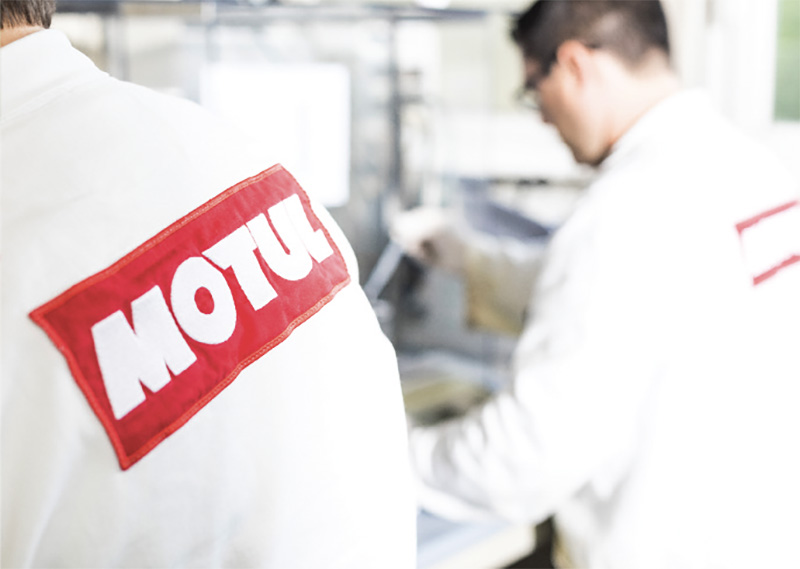
Motul provides the PMM audience with the inside scoop on the lubricants used in the garage.
Each moving part in a machine will require some form of lubrication. Simply put, therefore, a lubricant is a substance introduced between two moving surfaces to reduce friction and wear between them.
There are many types of machine/application, and a wide range of variables that affect a lubricating oil, such as: speeds, temperatures, loads (power/energy), operating conditions, composition of the machine parts, etc. Consequently, there are many different types of requirements for lubricating oils and many different oils.
Skilled technical engineers determine which oil should be used for which application, depending on the specific requirements and the oil parameters/characteristics, but most users – such as the average motorist – rely on product information provided to them by the company that built the machine, and the oil suppliers.
Lubricating oil is a blend of base oils and additives – coming together like pieces in a puzzle. Base oils are petroleum products derived by distilling crude oil in a refinery; additives are specialty chemicals added to base oils to improve/impart specific properties.
OEM engineers design their machines mindful of the type of oil needed. In most cases the oil required is characterised by a specification – usually a detailed technical document describing, in exact terms, the key pertinent properties of the oil.
The oil companies then determine how to make their products comply with said specification. Accordingly, the lubricant companies’ Research and Development departments work to determine the right mix of base oils and additives. This, once decided, is commonly referred to as the formulation or recipe.
“Consider wine makers who want to produce a fine wine to suit the palate of someone eating a particular type of food. They will mix together specific amounts of the different varieties of wine (Cabernet Sauvignon, Chablis, Merlot, etc.) and then taste the blend,” explains Motul UK’s Technical Manager, Has Tahier. “In the lubricant industry, in place of a wine’s colour, aroma and taste, the engineers and chemists use more exacting scientific techniques, although the principle is the same.”

Influences on lubrication specifications
First a blend of base oils is made in a large blending vessel – according to their properties. These are oily hydrocarbons or synthetic chemical liquids. Over its history, Motul has pioneered the use of the latter, being the first lubricant company to bring both semi-synthetic and fully synthetic oils to the automotive industry, with its introduction of Motul Century 21, the first semi-synthetic in 1966 and five years later, with Motul 300V, the world’s first fully synthetic motor oil.
This base oil mixture – typically comprising about 70- 90% of the final product – largely defines the important physical properties, notably the lubricant’s viscosity (ability to flow) at different temperatures, which is usually selected to suit the dimensions and power of the machine it will be used in.
Additives are blended into the mix, each of which imparts additional specific properties to the final oil. Some examples are:
- Anti-oxidants that prevent the oil from degrading under high temperatures
- Anti-wear additives to protect metal surfaces from excessive wear caused by mechanical friction
- Detergent and dispersants, used to keep the machine clean and suspend dirt particles in the oil, so they can be trapped in a filter
These important chemical additives are used from several parts per million to a few percent. They have to be added in precise quantities, even too much of one additive can impair the function of another, so getting the blend’s composition just right is important.
There is one other important function in the process – testing! Once the production team has thoroughly blended all the ingredients, a sample is sent to the laboratory. There, the key parameters are carefully tested to ensure the oil contains the correct amount of each component.
Any deviation from the desired target or specification will then be adjusted with the addition of small quantities of the component in question – pretty much as a good cook will taste his food and adjust the amount of salt or seasoning in order to achieve the desired overall taste.
Once completed, the final formulation is passed to the Lubricant Blending Plants, who make the oil to the defined formulation. The required quantities of each component are measured, added and blended together, before it can be sent through to the filling lines where the bottles and drums are filled.
All the incoming raw materials are also tested before they can be used and the oil is tested both before and after filling the packs.
Decoding the ratings
Lubricants come in different grades of viscosity – ie. how easily they flow – Monograde and Multigrade. Their rating tells you how they are designed to work in different conditions. Ratings are devised by the Society of Automotive Engineers – hence the SAE letters at the beginning of an oil rating.
Monograde oils tend to be used over a relatively small temperature range. They break down into two categories: those with a W and those without. The W stands for Winter and these are lower viscosity oils because, the lower the viscosity, the less hard the oil pump has to work during start-up – so the W ranges tend to be from 0-25: eg SAE10W.
Oils for Summer don’t have a W and they tend to be thicker to ensure the engine is properly sealed and protected during warmer months – so, for example: SAE50.
Most oils commonly in use are Multigrade – something which Motul brought to the automotive market in the 1950s, shepherding in oils for the modern era of vehicles.
Multigrade designations are a logical progression from Monogrades in terms of designation. So if you encounter SAE10W50, the first number before the W indicates the Winter viscosity grade and the number after represents the Summer viscosity grade.









